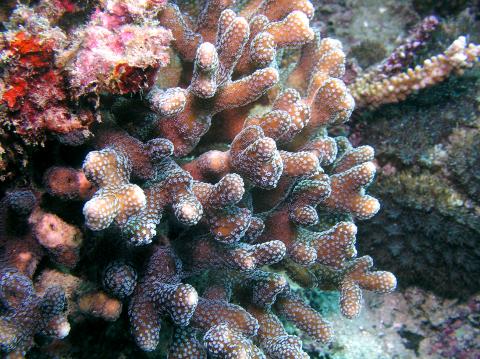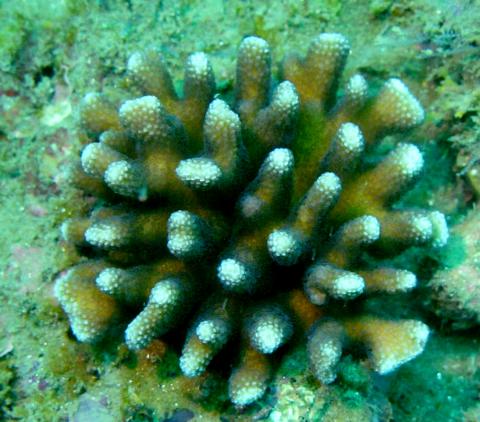An Academia Sinica research group recently overturned a three-centuries-old belief after discovering that Stylophora pistillata, a widely used “laboratory rat” for coral research, encompasses multiple subspecies rather than being just a single variant.
Led by Academia Sinica’s Biodiversity Research Center fellow Chaolun Allen Chen (陳昭倫), the research team found that Stylophora pistillata consists of at least four distinctive sub-types, with each having different levels of tolerance toward temperature and sunlight, overturning the long-standing belief, held since the 18th century, that Stylophora pistillata found worldwide belonged to one genetically homogeneous species.
The team, consisting of several marine biologists from Taiwan and abroad, reached the conclusion after using DNA barcoding to analyze mitochondrial cytochrome oxidase I (COI) gene sequences from 241 coral colonies collected from 34 locations across four marine areas, including the Western Pacific Ocean, the Indian Ocean, the Red Sea and the Persian Gulf.

Photo provided by the Biodiversity Research Center at Academia Sinica
The results of the study, which was subsidized by the National Science Council, have been published on the Scientific Reports Web site, a research journal from the publishers of Nature, on March 22.
According to Chen, S pistillata is a widely distributed coral species commonly used in scientific studies, but his research found that samples of the coral found in different areas showed different tolerances for a range of environmental factors.
“For instance, S pistillata samples collected from the Persian Gulf exhibit higher levels of heat tolerance than their Pacific Ocean counterparts,” Chen said, adding that the practice of conserving coral through assisted migration might result in biological invasions.

Photo provided by the Biodiversity Research Center at Academia Sinica
Chen said that as the four variants of S pistillata could have diverged from one another as long ago as 50 million years, past research on the species might also require re-examination.
Recalling the preparatory period for the six-year research project, Chen said that in an effort to collect coral samples from different habitats, he even traveled to Somalia, where piracy is prevalent.
“I had to be properly armed and escorted by US vessels before I could sail out to collect coral samples. Prior to that, I also had to go through the red tape to have access to species that are not only strictly protected, but also of high economic value,” Chen said.
“We could not have completed the project without going through the disappointments and hardships that we did,” Chen added.
Saying that DNA barcoding had been used to differentiate between closely related species and identify new ones, Chen added that the techniques could also be employed in border inspections in the future once an electronic database of DNA barcodes for various species has been established.
“By that time, customs officers could identify any smuggled species simply via a palm-sized device,” Chen said.

Chinese Nationalist Party (KMT) Chairman Eric Chu (朱立倫), spokeswoman Yang Chih-yu (楊智伃) and Legislator Hsieh Lung-chieh (謝龍介) would be summoned by police for questioning for leading an illegal assembly on Thursday evening last week, Minister of the Interior Liu Shyh-fang (劉世芳) said today. The three KMT officials led an assembly outside the Taipei City Prosecutors’ Office, a restricted area where public assembly is not allowed, protesting the questioning of several KMT staff and searches of KMT headquarters and offices in a recall petition forgery case. Chu, Yang and Hsieh are all suspected of contravening the Assembly and Parade Act (集會遊行法) by holding

PRAISE: Japanese visitor Takashi Kubota said the Taiwanese temple architecture images showcased in the AI Art Gallery were the most impressive displays he saw Taiwan does not have an official pavilion at the World Expo in Osaka, Japan, because of its diplomatic predicament, but the government-backed Tech World pavilion is drawing interest with its unique recreations of works by Taiwanese artists. The pavilion features an artificial intelligence (AI)-based art gallery showcasing works of famous Taiwanese artists from the Japanese colonial period using innovative technologies. Among its main simulated displays are Eastern gouache paintings by Chen Chin (陳進), Lin Yu-shan (林玉山) and Kuo Hsueh-hu (郭雪湖), who were the three young Taiwanese painters selected for the East Asian Painting exhibition in 1927. Gouache is a water-based

Taiwan would welcome the return of Honduras as a diplomatic ally if its next president decides to make such a move, Minister of Foreign Affairs Lin Chia-lung (林佳龍) said yesterday. “Of course, we would welcome Honduras if they want to restore diplomatic ties with Taiwan after their elections,” Lin said at a meeting of the legislature’s Foreign Affairs and National Defense Committee, when asked to comment on statements made by two of the three Honduran presidential candidates during the presidential campaign in the Central American country. Taiwan is paying close attention to the region as a whole in the wake of a

OFF-TARGET: More than 30,000 participants were expected to take part in the Games next month, but only 6,550 foreign and 19,400 Taiwanese athletes have registered Taipei city councilors yesterday blasted the organizers of next month’s World Masters Games over sudden timetable and venue changes, which they said have caused thousands of participants to back out of the international sporting event, among other organizational issues. They also cited visa delays and political interference by China as reasons many foreign athletes are requesting refunds for the event, to be held from May 17 to 30. Jointly organized by the Taipei and New Taipei City governments, the games have been rocked by numerous controversies since preparations began in 2020. Taipei City Councilor Lin Yen-feng (林延鳳) said yesterday that new measures by